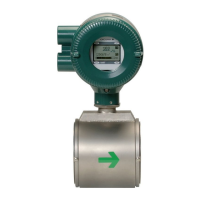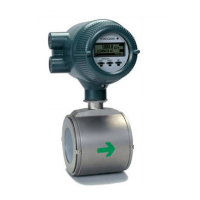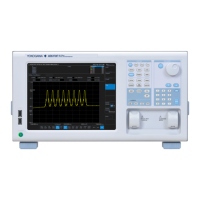Do you have a question about the YOKOGAWA ADMAG TI Series and is the answer not in the manual?
| Brand | YOKOGAWA |
|---|---|
| Model | ADMAG TI Series |
| Category | Measuring Instruments |
| Language | English |
Provides essential guidelines for safe operation and handling of the product, including warnings and cautions.
Details the warranty coverage, terms, and conditions, including exclusions and purchaser responsibilities.
Explains Fieldbus as a communication protocol for field devices and its role in process control systems.
Describes the internal structure of the product, including System/network Management VFD and Function Block VFD.
Illustrates the logical structure of various blocks within the Fieldbus system and their interconnections.
Details the necessary devices for Fieldbus operation, including power supply, terminator, field device, host, and cable.
Explains the required settings for the host to activate Fieldbus communication.
Provides instructions for powering on the system components and verifying operation on the bus.
Describes the process of integrating Device Description (DD) files with the host system.
Explains how to read parameters from the product via the host screen.
Guides on using the host function to continuously record indications (values).
Details the generation of block, out-of-range, and update alarms from the product.
Covers determining devices for Fieldbus, power supply capacity, and network design considerations.
Explains how to define the Fieldbus network, allocate PD tags and node addresses for all devices.
Details how function blocks are combined and the execution schedule for synchronous operation.
Describes the procedures to set PD Tag and node address for Fieldbus devices.
Covers setting the communication function, including VCR settings and function block execution control.
Explains how to set parameters for function block VFD, including link objects and alert objects.
Covers measurement of process values like flow velocity, mass flow, calorie, and setting parameters.
Details the totalizer functions, including value and unit settings, display, and conversion factors.
Explains the limit switch function for transmitting 0 or 1 based on process value and threshold comparison.
Describes how to input external temperature for density correction and calorie calculations.
Covers functions like fluid flow direction, rate limit, pulsing flow, power frequency sync, density, and calorie calculation.
Details alarm display, error codes, countermeasures, and alarm record/mask functions.
Covers display settings such as language, item display, decimal points, line count, scroll, and contrast.
Provides information on device details like order information, device revision, and memo function.
Explains self-check functions for diagnosing failures, including electrode adhesion, sensor empty, and wiring diagnostics.
Details test mode settings for arbitrarily setting flow velocity or output values for testing.
Covers parameter backup, restore, duplication, and data logging functions using the microSD card.
Explains how to enable write lock using hardware switch or software settings to prevent data modification.
Describes the simulation function to test function blocks and alarm processing by simulating input data.
Details output functions for terminals, including pulse width, rate scaling, and status output.
Lists parameters for the resource block, including Block Header, ST_REV, TAG_DESC, and MODE_BLK.
Details parameters for the sensor transducer block, covering calibration, types, and values.
Lists parameters for the diagnosis transducer block, covering adhesion, flow noise, conductivity, and insulation.
Provides parameters for the display transducer block, including line selections, contrast, and format settings.
Details parameters for the maintenance transducer block, including device information and software download settings.
Lists parameters for the AI function block, covering MODE_BLK, PV, OUT, XD_SCALE, and OUT_SCALE.
Details parameters for the DI function block, including PV_D, OUT_D, SIMULATE_D, and status options.
Lists parameters for the MAO function block, including channel selection and fault state transmission.
Provides a reference table for unit codes used in the system.
Provides an overview of the display menu structure and operation levels.
Explains the applications and selection of basic parameters for AI and DI function blocks.
Describes procedures for setting and changing parameters for each block, including block modes.
Details how to set the flow range, output scale, and simulation for the AI function block.
Explains setting the unit of flow rate totalization and forward/reverse direction for the IT block.
Covers setting the channel, damping time constant, and simulation for the DI function block.
Provides the functional block diagram of the Integrator (IT) block.
Details the input process section, including determining input value statuses and converting rate/accum.
Explains the adder function, including status of value after addition and addition options.
Describes the integrator function, including integration methods and types of integrated values.
Details the output process, including status determination and output value determination.
Explains reset processing, including reset triggers, reset timing, and reset process.
Provides a list of parameters for the Integrator block.
Shows the functional block diagram of the Arithmetic (AR) block.
Details the input section, including main inputs, auxiliary inputs, and input options.
Explains computing equations, compensated values, and average calculation for the AR block.
Describes the output section, including mode handling and status handling.
Provides a list of parameters for the Arithmetic block.
Explains the Link Active Scheduler (LAS) and its functions on the Fieldbus network.
Describes Link Master (LM) devices and their role in the network, including LM device and Basic Device.
Details the procedures for an LM device to become the LAS, including backup and failure scenarios.
Lists and describes the functions of the Link Master (LM), such as initialization and CD transmission.
Provides a list of LM parameters, including basic characteristics and link settings.
Offers detailed descriptions for LM parameters like DlmeLinkMasterCapabilitiesVariable and DlmeLinkMasterInfoRecord.
Presents the functional block diagram of the PID block, illustrating its components and flow.
Details the various functions of the PID block, including control calculation and mode changes.
Provides a comprehensive list of parameters for the PID block, including default values and write modes.
Explains PID computation methods, including Proportional Derivative Leading Type and algorithm parameters.
Describes the control output action, focusing on the velocity type and its calculation.
Explains how to switch the output direction based on deviation changes, specified by CONTROL_OPTS.
Details the control action bypass function, allowing SP value to be set as operation output.
Explains the feed-forward control action, which adds compensation to the PID output signal.
Defines the block modes and describes the eight available modes and their transitions.
Describes bumpless switching for MODE_BLK and operation values without sudden control output changes.
Explains the setpoint limiter function to limit SP settings based on block mode.
Details external tracking action, outputting set value of operation output when block mode is LO.
Describes measured-value tracking to equalize setpoint to measured value in Man mode.
Explains the abnormality processing function that suspends control action by changing block mode to IMan.
Describes manual fallback function, changing mode to Man and suspending control action when input status is BAD.
Details AUTO fallback mode, changing from Cas to Auto and continuing automatic PID control.
Explains mode shedding functions when data status of RCAS_IN or ROUT_IN falls to BAD.
Covers block alarm processing, including block alarms and process alarms.
Provides an example of connecting AI, PID, and AO blocks for a simple PID control loop.
Highlights the advantages of the software download function for updating field devices.
Outlines the specifications of the software download function, including power consumption and class.
Lists the necessary preparations for software downloading, including tools and files.
Provides a flowchart of the software download procedures, from starting the tool to activating the device.
Explains the naming conventions for download files and the difference between ORIGINAL and UPDATE files.
Details the steps to perform after activating a field device, including checking software revision and reconfiguring parameters.
Provides solutions for common problems encountered during or after software update.
Lists VFD parameters related to software download, such as DWNLD_PROPERTY and DOMAIN_DESCRIPTOR.
Provides comments and explanations for System/Network Management VFD parameters related to software download.











